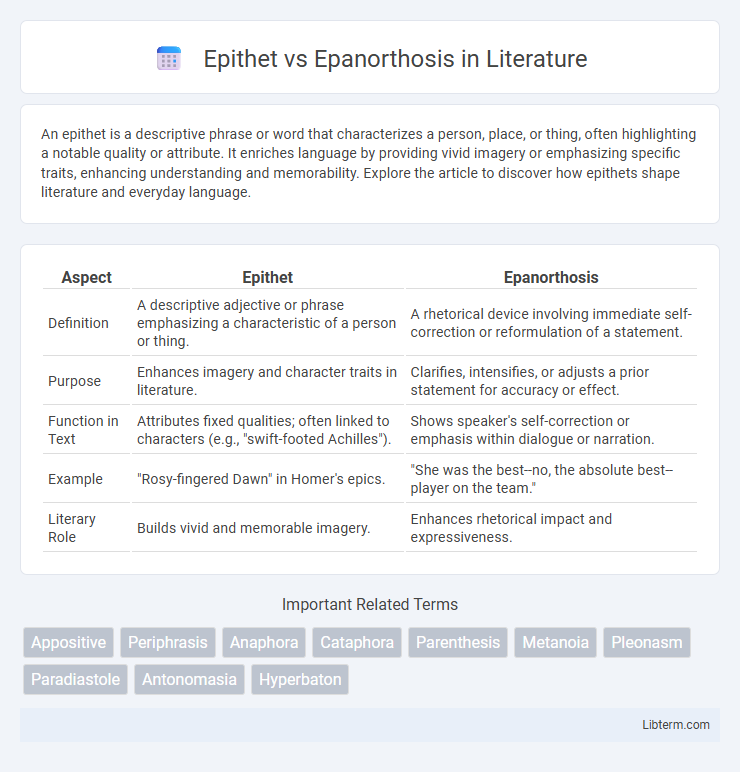An epithet is a descriptive phrase or word that characterizes a person, place, or thing, often highlighting a notable quality or attribute. It enriches language by providing vivid imagery or emphasizing specific traits, enhancing understanding and memorability. Explore the article to discover how epithets shape literature and everyday language.
Table of Comparison
| Aspect | Epithet | Epanorthosis |
|---|---|---|
| Definition | A descriptive adjective or phrase emphasizing a characteristic of a person or thing. | A rhetorical device involving immediate self-correction or reformulation of a statement. |
| Purpose | Enhances imagery and character traits in literature. | Clarifies, intensifies, or adjusts a prior statement for accuracy or effect. |
| Function in Text | Attributes fixed qualities; often linked to characters (e.g., "swift-footed Achilles"). | Shows speaker's self-correction or emphasis within dialogue or narration. |
| Example | "Rosy-fingered Dawn" in Homer's epics. | "She was the best--no, the absolute best--player on the team." |
| Literary Role | Builds vivid and memorable imagery. | Enhances rhetorical impact and expressiveness. |
Understanding Epithet: Definition and Usage
Epithet is a descriptive phrase or adjective used to characterize a person, place, or thing, often highlighting a distinctive quality or attribute, such as "Alexander the Great" or "rosy-fingered dawn." It enhances literary works by adding vivid imagery and deepening readers' understanding of characters or settings. Unlike epanorthosis, which involves immediate correction or clarification of speech, epithet serves primarily as an enduring descriptive label.
What Is Epanorthosis? A Clear Explanation
Epanorthosis is a rhetorical device used to immediately correct or clarify a previous statement for precision or emphasis, enhancing the speaker's or writer's intent. Unlike an epithet, which is a descriptive term or phrase expressing a characteristic of a person or thing, epanorthosis serves as an explicit self-correction that refines meaning. This technique strengthens communication by ensuring accuracy and reinforcing key ideas in both spoken and written language.
Key Differences Between Epithet and Epanorthosis
Epithet is a descriptive term or phrase expressing a characteristic quality of a person or thing, often used for emphasis or identification, such as "Alexander the Great," while epanorthosis involves the immediate self-correction or rephrasing of a previous statement to clarify or intensify meaning. Epithet functions primarily as a fixed attribute or metaphorical label, enhancing imagery or character recognition, whereas epanorthosis serves a rhetorical purpose in spoken or written discourse to modify or refine speech in real time. The key difference lies in epithet being a static, figurative label, whereas epanorthosis is a dynamic linguistic technique for correcting or emphasizing a statement within communication flow.
Historical Origins and Literary Significance
Epithet originates from ancient Greek literature, serving as a descriptive phrase that characterizes a person or thing, enhancing the narrative by providing vivid imagery or emphasizing particular traits, famously seen in Homeric epics. Epanorthosis, also rooted in classical rhetoric, involves the immediate correction or reinterpretation of a statement to strengthen argument or clarify meaning, reflecting speakers' precision in ancient Greco-Roman discourse. Both devices hold significant literary importance: epithets enrich characterization and thematic depth, while epanorthosis demonstrates rhetorical skill and engages readers through textual self-editing.
Common Examples of Epithets in Literature
Common examples of epithets in literature include Homeric phrases such as "swift-footed Achilles" and "rosy-fingered Dawn," which vividly characterize individuals or elements by attributing specific qualities. Epithets serve to create memorable images and reinforce thematic elements, often appearing in classical poetry and epic narratives. Unlike epanorthosis, which involves immediate verbal correction, epithets consistently maintain descriptive emphasis throughout the text.
Epanorthosis: Illustrative Examples in Writing
Epanorthosis is a rhetorical device used to immediately correct or modify a previous statement for emphasis or clarity, often strengthening the expression by self-revision. In writing, examples include phrases like "He is the best player--no, the greatest player on the team," or "The project will take six months, or rather, eight to ten months to complete." By integrating epanorthosis, authors create a dynamic and precise narrative that captures the evolving thought process and enhances reader engagement.
Purpose and Effect: Epithet vs Epanorthosis
Epithet enhances characterization by attaching descriptive qualities to a noun, enriching imagery and emotional impact in literature. Epanorthosis serves to correct or refine a statement, emphasizing precision or intensifying the speaker's intention. Both devices shape communication--epithets add vividness, while epanorthosis sharpens clarity and forcefulness in expression.
How to Identify Epithets and Epanorthosis in Texts
Epithets can be identified in texts as descriptive adjectives or phrases that characterize a person, place, or thing, such as "swift-footed Achilles" or "rosy-fingered dawn," providing vivid imagery and reinforcing traits. Epanorthosis is recognized by the immediate correction or rephrasing of a previous word or statement, where the speaker self-corrects for emphasis or clarity, often introduced by phrases like "or rather" or sudden shifts in wording. Distinguishing epithets involves spotting consistent, metaphorical labels, while epanorthosis involves noticing deliberate verbal adjustments within a sentence.
Role in Creative Writing and Rhetoric
Epithet enhances creative writing and rhetoric by providing vivid, descriptive labels that reinforce character traits or thematic elements, making narratives more memorable and engaging. Epanorthosis, on the other hand, functions as a self-corrective rhetorical device that adds emphasis, clarifies meaning, or heightens emotional impact by revising a previous statement. Both devices enrich expression, with epithet deepening characterization and epanorthosis refining persuasive or dramatic effect.
Choosing the Right Device: Practical Tips for Writers
When choosing between epithet and epanorthosis, writers should consider the purpose and tone of their work; epithets provide concise, vivid characterization by attaching descriptive qualities directly to a noun, enhancing imagery and emotional impact. Epanorthosis, involving immediate self-correction or clarification, serves to refine statements or emphasize precision, often adding a conversational or rhetorical effect. Effective use hinges on context: select epithets for lasting descriptive resonance and epanorthosis for dynamic, nuanced expression that guides reader interpretation.
Epithet Infographic

 libterm.com
libterm.com